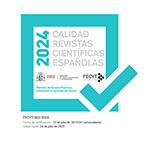Gender inequality in the labor market in Spain in times of global health crisis
Abstract
Introduction. This article makes a recent review of the progress towards gender equality in the workplace, considering that this is one of the objectives of sustainable development and its progress or stagnation is of national and international interest, especially in times of crisis. Objective. The objective is to contrast the recent and current evolution (pre and pandemic) of the labor market in Spain, identifying features or characteristics that perpetuate gender inequalities, from a feminist view of the economy. Methodology. Using microdata from the Economically Active Population Survey (EPA), a quantitative analysis is carried out which includes the characterization of the labor market since the year prior to the pandemic and the study of distribution, concentration and gender segregation, for which the Duncan and Karmel and Machalan methods are used. Results. The assignment of gender roles in reproduction and production continues to affect the functioning of the labor market, perpetuating gender segregation and making it impossible to eliminate differences; the crisis tends to affect women first, and to a greater extent, given the characteristics of their occupations. Contribution. It highlights the need to generate public policies for the elimination of segregation and to prepare women for the global transformation that the pandemic has accelerated.
Downloads
Article download
License
In order to support the global exchange of knowledge, the journal Investigaciones Feministas is allowing unrestricted access to its content as from its publication in this electronic edition, and as such it is an open-access journal. The originals published in this journal are the property of the Complutense University of Madrid and any reproduction thereof in full or in part must cite the source. All content is distributed under a Creative Commons Attribution 4.0 use and distribution licence (CC BY 4.0). This circumstance must be expressly stated in these terms where necessary. You can view the summary and the complete legal text of the licence.











